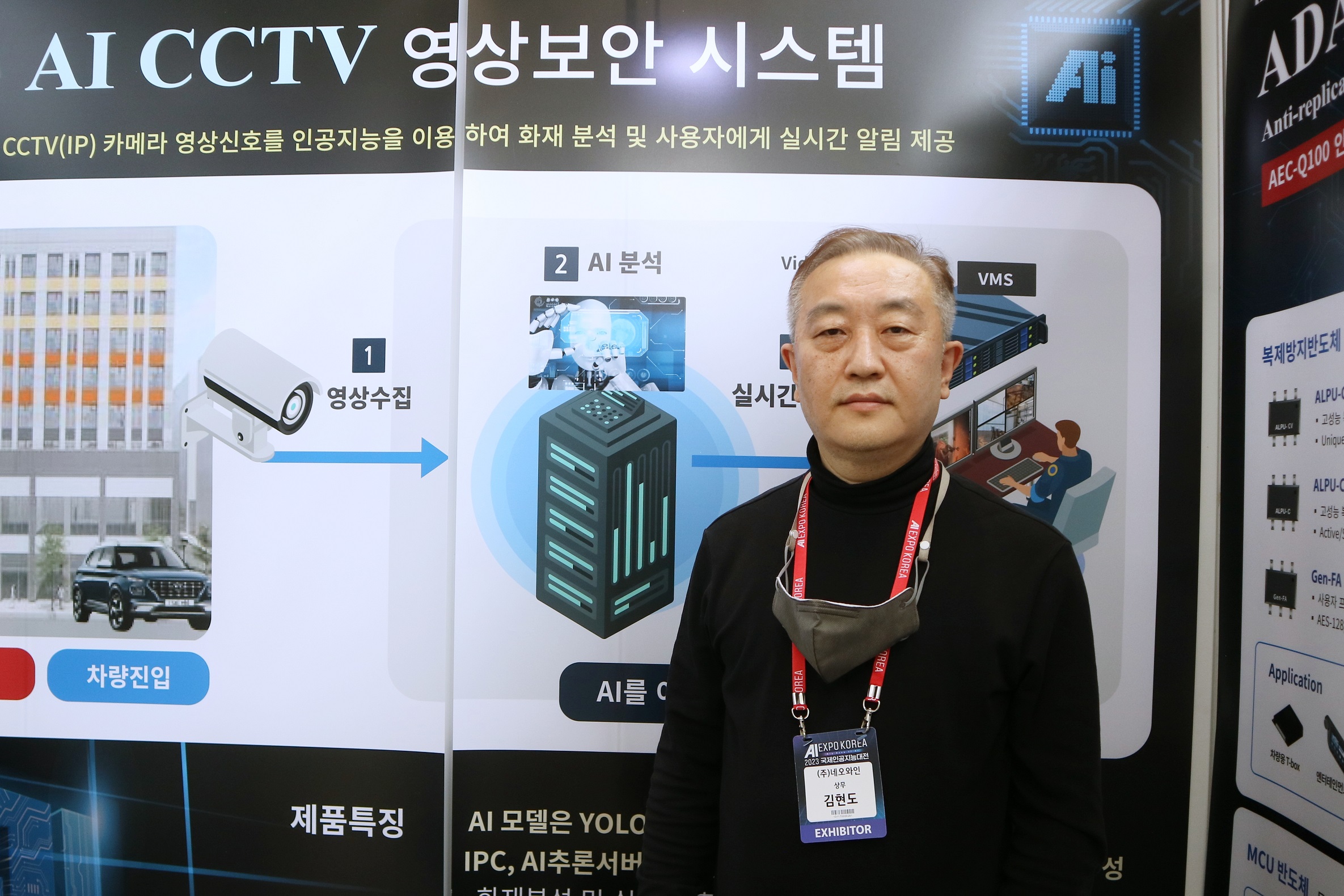“AI칩 시장이 서버에서 엣지단으로 점차 전진 배치되고 있다. AI 애플리케이션들의 리얼타임 동작을 보다 고도화하기 위해 엣지에서의 수요는 계속 커질 것이라고 생각한다”

▲김현도 네오와인 신사업개발본부장 겸 상무
AI칩에서부터 SW까지 통합 솔루션 제공
엣지 시장 집중 공략, 고객 맞춤 대응 必
“AI칩 시장이 서버에서 엣지단으로 점차 전진 배치되고 있다. AI 애플리케이션들의 리얼타임 동작을 보다 고도화하기 위해 엣지에서의 수요는 계속 커질 것이라고 생각한다”
국내 팹리스 기업을 둘러싼 환경은 쉽지 않다. 시스템 반도체의 불모지란 타이틀 속에서도 국내 팹리스들은 시장 추세에 대응하는 첨단 제품 개발에 여념이 없다.
김현도 네오와인(Neowine) 신사업개발본부장은 네오와인이 엣지 AI 시장에서 새로운 먹거리를 찾고 있다고 말했다. 기존 보안 반도체에서 영역을 확장한 엣지 AI칩 반도체와 AI 소프트웨어 솔루션 개발한 끝에 하드웨어와 소프트웨어를 통합하는 End-to-end 서비스를 시장에 선보이고 있다.
본지는 5월11일 2023 국제인공지능대전 전시회에서 김현도 네오와인 신사업개발본부장과 만나 네오와인의 엣지 AI 솔루션에 대해 들어봤다.
■ 반도체 개발뿐 아니라 AI 솔루션 개발도 하고 있나
하드웨어(HW) 칩 설계와 더불어 소프트웨어(SW) 개발도 하고 있다. 정보통신산업진흥원에서 지원을 받아 AI SW 개발도 2021년부터 시작했다.
■ 원래 전문 분야는 보안 및 암호화 칩 분야이다. AI 분야까지 진출하게 된 계기가 궁금하다
네오와인은 보안 반도체가 주력 제품이며 관련 분야에 오랜 업력을 갖고 있는 것은 맞다. 보통 제품을 개발하게 되면 HW뿐 아니라 SW도 같이 개발하게 된다. 이때 SW단에 AI 알고리즘들이 많이 적용되다 보니 AI 솔루션까지 개발하고 서비스를 출시하기에 이르렀다.
보안칩을 예로 들어 설명하자면, 예컨대 차량용 어라운드 뷰 주차시스템을 개발해 보안칩 없이 해외 수출을 하다 보면 해킹의 위험에 노출될 수 있다. 네오와인은 이러한 시스템 하드웨어에 탑재되는 MCU 옆에 보안칩을 적용시켜 관련 위험에 대응하는 솔루션을 갖고 있다. 보안칩은 자물쇠와 같은 역할을 해 올바르지 않은 접근들을 차단한다.
이 같은 복제 방지, 암호화 보안 칩에서 더 나아가 IoT 보안과 데이터 암호화로 확장하며 현재 AI 반도체쪽으로 발전하게 됐다. 정부 지원 R&D를 통해 2년 간 반도체 IP 개발을 완료했으며, 칩 제작을 진행하는 단계에 있다.
■ 현재 이곳 인공지능대전에서 선보이고 있는 AI 솔루션에 대해 설명 부탁한다
불법 복제품 판독 시스템으로 인공지능을 이용한 이미지 검색과 판독 솔루션을 개발해 시장에 선보이고 있다. 관세청 등에 적용 가능한 솔루션으로 의심 물품 판독 및 디자인 특허 침해 여부 등을 감별하기 위해 개발됐다.
또한 AI CCTV 영상보안 시스템에서 적용되는 불꽃 및 연기 감지 AI 모델을 개발해 상품화를 진행하고 있다. AI 모델이 적용되는 시스템은 엣지 디바이스 카메라에 탑재되거나 혹은 엣지와 서버단 사이의 엣지 서버단에 AI 시스템을 적용해 수집된 영상을 분석하고 처리하는 시스템을 구축할 수 있다.
현재 CCTV 카메라에 들어갈 수 있는 칩 개발에 매진하고 있으며, 더불어 칩 위에 올라가는 AI 모델 개발에 주력해서 제품화·고도화를 진행하고 있다.
■ 현재 제품들은 기술 및 시장 측면에서 어떤 부분에 주안점을 두고 차별화를 추구하고 있나
국내 반도체 메이커들은 주로 서버 시장에 많이 뛰어들고 있다. 네오와인은 엣지단에 초점을 맞춰 제품을 선보이고 있다.
영상 카메라를 보면 소형화된 칩 사이즈와 저전력의 스펙을 요구하고 있다. 이에 실시간 연산과 처리가 되는 성능의 엣지 AI 칩을 제품화해 IoT, 엣지 디바이스쪽 시장에 초점을 맞춰 제품 개발에 주력하고 있다.
마찬가지로 엣지단 칩을 제작하는 ST, TI 등과 비교할 때 물량이 적은 고객사에 대해서도 기술 대응이 가능해 이러한 점에 강점이 있을 것으로 보고 있다.
현재 엣지단 AI 모델 실시간 고속연산처리를 위한 AI반도체 설계 IP와 AI칩에 올라가는 AI모델 최적화에 필요한 컴파일러 SW까지 개발했다. 이를 단순 제품 공급뿐 아니라 고객 환경에 맞게 IP 및 SW 커스터 마이징 서비스를 제공해 공급할 수 있으며, 기술 컨설팅 서비스도 제공하고 있다.
■ 개발된 AI칩 제품 특징에 대한 설명 부탁한다
NPU IP는 1,024개 MAC 어레이 프로세서로 구성된 NPU 코어와 다수의 오퍼레이터들로 구성됐다. 연산자 Conv3D, Conv1x1, Depthwise, Convolution, Matmul 등 다수의 오퍼레이션을 지원하며 기본 성능은 4TOPS 수준이다.
컴파일러 SW는 ONNX 구조로 텐서플로, 파이토치 등 다양한 프레임워크에서 개발된 AI 모델 수용이 가능하며, △AI 모델 양자화 △오퍼레이터 퓨전으로 경량화 △고속화를 위한 컴파일러 등의 특징을 지닌다.
■ 국내 팹리스 업계서 제품화에 가장 어려운 지점이 무엇이라고 보는가
비용이 가장 큰 문제라고 생각한다. 제품 개발엔 인력, 자원 등 많은 개발 리소스가 투입되기에 개발 비용 문제가 가장 민감하게 작용한다. 대기업은 비즈니스 섹터가 넓고 매출 구조가 다변화돼 있어 안정적인 수익을 창출해 관련 재원을 마련할 수 있지만 중소기업의 경우는 그렇지 못한 경우가 많다.
시간과 비용, 인력의 3요소는 트레이드 오프 관계에 있고, R&D 비용이 수반되지 않는다면 완성도 높은 제품 개발에는 상당한 시일과 어려움이 잇따르게 된다. 국내 반도체 및 AI 인재 교육 사업들이 활성화되고 향후 그런 부분에 인력 지원을 받을 수 있다면 상황이 나아지지 않을까 기대하고 있다.